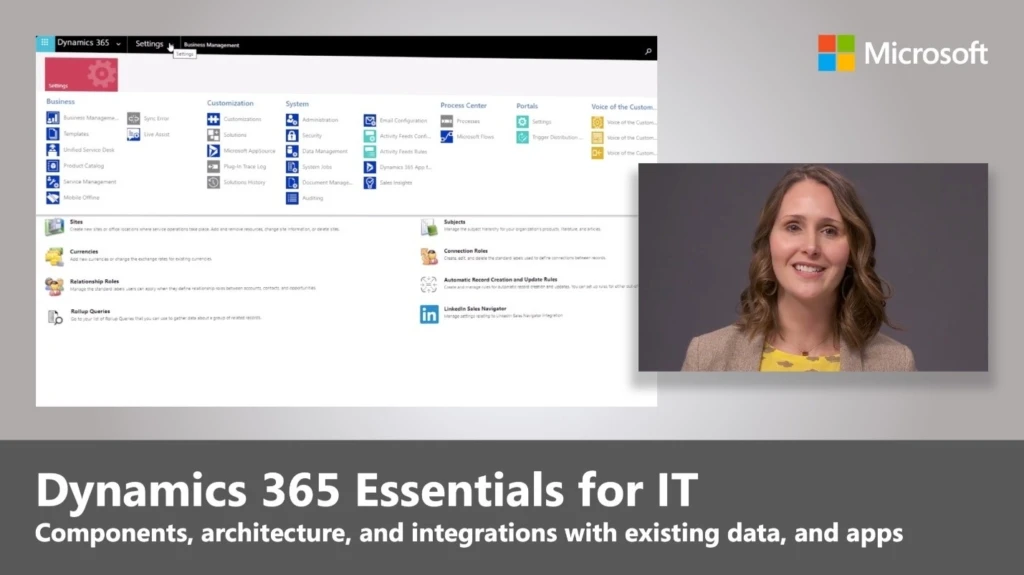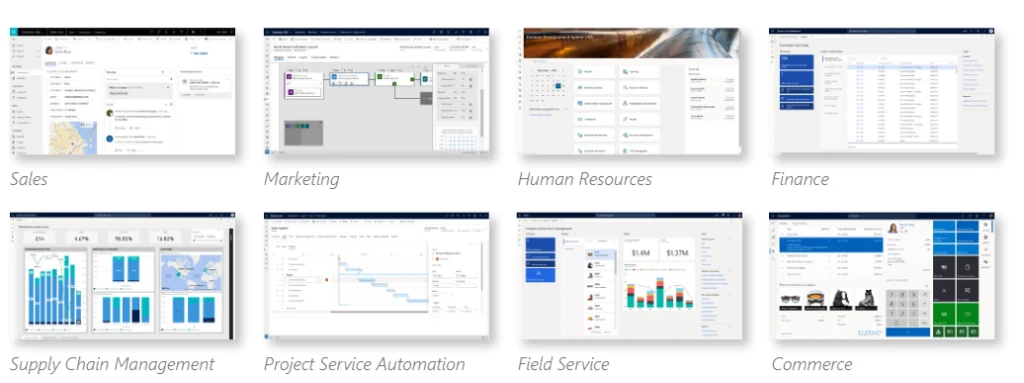
Understanding Dynamics 365 for IT: Architecture, integration, and more
If you work in an IT department, chances are you’ve seen or heard of Microsoft Dynamics 365. It’s a set of modular and connected software as a service (SaaS) applications and services that are designed to integrate with your existing data, business logic, and processes to help transform and unify your customer relationship management (CRM) and enterprise resource planning (ERP) business functions.
As more and more organizations deploy Dynamics 365 and look to customize or tailor capabilities to specific requirements, in many cases you’ll already have the in-house expertise needed to perform these tasks and not always have to rely on outsourced consulting or software development help. And with many of the shared underpinnings from Microsoft Power Platform like Microsoft Power Automate, Power Apps, Power BI, and the Common Data Service, we’re also making huge strides in getting what we like to call citizen developers involved, so that just about anyone can build out new apps, workflows, and insights without knowing how to write code and customize Dynamics 365 services to your needs.
Understanding Dynamics 365 at the technical level
While the access to developing custom solutions with minimal expertise is incredibly powerful, if you do have a background in IT, software architecture, data, or cyber security, it helps to know the foundational components, the administrator options available, and the underlying architecture that Dynamics 365 is built on. To that end, we’re working with IT pro teams within Microsoft and across disciplines to highlight what you need to know, whether you’re new to Dynamics 365 or looking to add new applications and integration to your existing deployment. We’ve just kicked off a series about Dynamics 365 for IT professionals on Microsoft Mechanics and there are more resources highlighted below. Watch this intro video to learn more.

What’s in Microsoft Dynamics 365?
Dynamics 365 applications span sales, marketing, human resources, finance, supply chain management, project service automation, field service, commerce, and more.

These can be implemented together or individually and you can start with one application and easily add additional Dynamics 365 applications to expand your capabilities and integrate them with your existing systems. Built-in intelligence allows you to derive fast and actionable insights that can be optimized even further when you leverage the purpose-built AI of Dynamics 365 Customer Insights. All applications are web-based and responsive to screens of all sizes and we have a consolidated Dynamics 365 for phones app that supports modern multifactor authentication and mobile device management (MDM) controls to meet your security requirements.
Common Data Service and Common Data Model for data integration
As you adopt Dynamics 365, you can determine which systems and data you would like to stay on premises versus moving them to the cloud.
Central to Dynamics 365 is the Common Data Service (CDS) and its Common Data Model (CDM). This provides a foundation for data integration across all Dynamics 365 applications and services, your productivity and collaboration apps in Microsoft 365, your in-house systems, and even your SaaS applications in other clouds.
The Common Data Service is a heterogeneous storage service for both structured tabular data and unstructured data such as images or log files. It runs in Microsoft Azure and is shared by Dynamics 365 applications, Microsoft 365, and the Microsoft Power Platform. The Common Data Service understands the shape of your data and the business logic over your data.
The Common Data Model supports a consistent way of shaping and connecting your data, and we’ve open sourced the schemas we use in the Common Data Service which is the foundation of what we call the Common Data Model or CDM. The Common Data Model defines entities, attributes, semantic metadata, and relationships to provide consistency in how data is defined and connected across applications. Dynamics 365 partners with leaders across industries like healthcare, retail, financial services, education, and automotive to extend the Common Data Model with industry-specific, common, and interoperable schemas.
To integrate your existing systems and business processes with Dynamics 365 and the Common Data Service, there are hundreds of pre-built connectors covering popular data platforms and apps to allow you to connect to your existing systems for both read-only processes such as a one-time batch operation and read-write communications.
These connectors take care of which APIs to call, how to authenticate, and how to pass data back and forth between applications with shared workflows. This gives you the ability to create custom app experiences and automate processes in a fraction of the time, all with zero to minimal code, using secure authentication and per user or role-based data access controls.
Configuring Dynamics 365 security and access controls
As a system administrator, you have ultimate control over how Dynamics 365 services and applications are configured to meet your business and security needs with provided administration tools and settings. You can grant users access to Dynamics 365 services using the Microsoft 365 admin center via Microsoft Azure Active Directory.
If you’re familiar with the controls across Microsoft 365 workloads like Microsoft SharePoint, OneDrive, Teams, and Exchange, you can leverage the same security and compliance settings with capabilities like data loss prevention and eDiscovery, while allowing your sales teams to securely collaborate on files with other departments or partner organizations, who may not have access to Dynamics 365 experiences.
We also give you granular admin controls to define individual access or security groups and you can also specify access rules within the specific fields used in our app experiences to remove sensitive information from view and for example, to set read-only access. Equally, we give you encryption options. For example, you can use your own encryption keys to protect data from unauthorized access, viewing, or export.
Microsoft 365 and Azure integration
Powerful native integration with Microsoft 365 means that as your users work in Dynamics 365, they can do so within their day to day productivity apps such as Microsoft Teams and Outlook email. This gives your users a seamless, uninterrupted experience as they can use Dynamics 365 without needing to switch between apps. Also, because Dynamics 365 is built on Microsoft Azure, you can take advantage of the vast ecosystem of services within Azure to extend the capabilities and intelligence in Dynamics 365.

Customizing your app experiences
One of the major advantages of Dynamics 365 is the integration with Microsoft’s Power Platform, allowing you to build custom and automated experiences around your data and processes using Power BI, Power Apps, and Power Automate, all with zero to minimal coding.
This has the added advantage of allowing even non-technical users to safely build custom app experiences on their own. Power Apps provides a PowerPoint-like, point-and-click application creation experience. Power Automate gives you a visual workflow engine to easily transform and connect your manual business processes and Power BI gives you a powerful data visualization and analytics tool. You can also use AI Builder to apply machine learning to improve your business insights and processes.
Service monitoring and high availability
Because Dynamics 365 runs on Azure, it benefits from Microsoft’s expansive cloud fabric and data centers globally. If your users are spread across different locations, you can host your Dynamics 365 services and your data in available data center regions around the world, and in proximity to your users to reduce latency. These low latency, high bandwidth connections in addition to the computational power in Azure are also key to our AI-driven insights applications, allowing efficient, integrated AI experiences to save you, your analysts, and your users time.
Additionally, we give you admin-level visibility into overall service performance affecting your tenants. Microsoft operates its Dynamics 365 services to provide 99.9 percent or higher availability.
Continuous compliance
Dynamics 365 and related services are continually updated and independently audited to meet regional and industry requirements. Services are General Data Protection Regulation (GDPR) compliant and support major global, government, regional, and industry regulations. The services within Dynamics 365 comply with applicable data protection and privacy laws and are built from the ground up to address your most rigorous security and privacy needs.
With our compliance framework of industry verified controls built into the service, we make it easier for your organization to both comply to existing standards or respond to new standards and regulations as they arise. You can use our Service Trust Portal and compliance manager to assess your current state of compliance, learn about recommended controls to implement against a specific regulatory requirement, and identify which controls Microsoft has in place to operate Dynamics 365 and dependent services.
Next steps and continued learning
We are on a long-term journey to build our Dynamics 365 content library and resources out for IT, developers, and data analysts so that you can find what you need to take your Dynamics 365 implementations to the next level.
Keep checking back to our series on Microsoft Mechanics for visual tours across our core services and capabilities in Dynamics 365.
Review the most up-to-date technical documentation for Dynamics 365 and check out our broad range of online learning paths and modules.
For help with onboarding Dynamics 365 for your organization, engage with our FastTrack onboarding services, and Microsoft system engineers along with our network of authorized partners, who’ll work hand-in-hand with your internal teams to get you up and running quickly.




